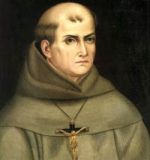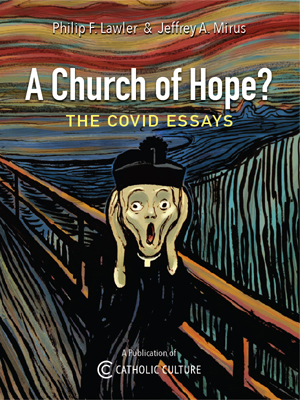Mary: Terrible as an Army, Arrayed for Battle
By Fr. Jerry Pokorsky ( bio - articles - email ) | Sep 12, 2022
When we consider world religions, the eastern religions disappoint. Buddhist Nirvana is an implausible doctrine. The prospect of reincarnation is as terrifying as it is unrealistic. Muslim religious views also disappoint. The denial and suppression of free will are offensive to authentically human sensibilities and untenable. (Every sin is an abuse of free will.)
The Jewish faith poses challenges to Catholics because of its beauty, majesty, and reasonableness. Mary helps us reconcile Jewish belief with the Christian faith.
Most elements of traditional Jewish teaching have a Catholic appeal. The rabbis emphasize the compatibility of the natural with the holy in the covenant. They acknowledge God’s quest for man and the unique existence of the Jews following the call of Abraham as the Chosen People to declare God’s glory. They describe how God’s directives calibrate the simple acts of ordinary lives to holiness under His sovereignty.
Catholics do not quarrel with these beautiful foundational aspects of the Jewish religion. Neither does Mary. The holiness of Mary provides a stark argument in favor of the truth of traditional Judaism. Indeed, Mary illustrates how Jewish belief complements the Catholic understanding of the Old Testament.
Mary was born a Jew. Her parents—Joachim and Ann—were devout and holy Jews. Mary studied the Old Testament, recited the Psalms, heard the Word of God in the synagogues, and made offerings according to the prescriptions of the Law (cf. Lk. 2:23-24). Mary—“our tainted nature’s solitary boast” (William Wordsworth, 1822)—was conceived without Original Sin and, being filled with grace, committed no personal sins. The former was by God’s unique favor, and the latter was by Mary’s cooperation with God’s grace she received through her Jewish upbringing.
Since the Devil tempted her son Jesus, we can surmise that the Devil also tempted Mary. Her temptations may have been similar to Eve’s—“You will be like God, knowing good and evil.” (Gen. 3:5) She is “full of grace” according to the Angel Gabriel (cf. Lk. 1:28) But Mary never sinned. How did Mary attain and maintain the necessary virtue to avoid sin?
Mary’s holiness is Jewish—and Christian. Saint Paul writes, “In many and various ways God spoke of old to our fathers by the prophets; but in these last days, he has spoken to us by a Son, whom he appointed the heir of all things, through whom also he created the world. (Hebrews 1:1-2) Mary cracked the code. She defragmented the Scriptures and found Jesus even before she said, “Behold, I am the handmaid of the Lord; let it be to me according to your word.” (Lk. 1:38)
We can say with certainty that Old Testament teaching formed Mary. Her masterpiece of prayer in the Gospel of Luke, “The Magnificat” (Lk. 1:46-55), is rooted in the Old Testament. She rephrases the Canticle of Anna, the Psalms, Malachi, Job, Isaiah, and Genesis. Mary knew her Bible and Jesus learned the content of Judaism from her and Joseph.
Beyond the Infancy Narratives of the Gospel, Mary appears infrequently. She intercedes with Jesus on behalf of the wedding guests at Cana and has a brief appearance with family members during the Lord’s public life. She is the sorrowful mother faithful at the foot of the Cross, and Mary receives the Holy Spirit with the Apostles on the first Pentecost. Mary is the model of the Church, the holy Bride of Christ.
All of these facts of Catholic dogma attest to Mary’s role in validating the doctrinal strength of the Old Testament. Mary fulfills the Old Testament with her sanctity and introduces us to Jesus. Jesus fulfills the Scriptures with the Cross and Resurrection.
We find Jesus throughout the Old Testament. Isaac, the son of Abraham, foreshadows Him. Jesus is the “new Moses,” delivering His people from slavery to sin. He is the Suffering Servant of Isaiah the Prophet. He is the promised Messiah. After the Resurrection, on the road to Emmaus, Jesus explains: “Was it not necessary that the Christ should suffer these things and enter into his glory?’ And beginning with Moses and all the prophets, he interpreted to them in all the scriptures the things concerning himself.” (Lk. 24:25-47)
Mary found Jesus in the Psalms. “The words of the Psalmist, sung for God, both express and acclaim the Lord’s saving works; the same Spirit inspires both God’s work and man’s response. Christ will unite the two. In him, the psalms continue to teach us how to pray” (CCC 2587). The Gospel reveals, “Jesus increased in wisdom and in stature, and in favor with God and man.” (Luke 2:52) From the Cross, Jesus quoted Psalm 22, which He likely learned from Mary: “My God, my God, why hast thou forsaken me?” (Mt. 27:46)
When priests, religious, and others pray the predominantly Old Testament readings of the Divine Office, Mary is in their midst, praying and guiding them as our Mother in the order of grace (cf. CCC 968). Mary delights in creation, receives Divine instruction, heeds the warning of the Psalms about the dangers of sin, and seeks the Psalms for consolation in times of trouble. The Jewish religion—fulfilled by Jesus—formed Mary, and her holiness directs us to Jesus, and she directs us to Him. Her last recorded words are: “Do whatever he tells you.” (Jn. 2:5)
Mary is the perfect Jew and flawless Christian, Mother of God, Mother of the Church, and our Mother. She is a warrior, prefigured in Deborah and the Mother of the Maccabees. Mary is “terrible as an army, arrayed for battle.” (Song of Solomon 6:10) Mary is the “woman clothed with the sun” (Rev. 12:1) who protects her children and crushes the head of the ancient serpent (cf. Gen 3:15). Mary teaches us how to pray the Old and the New Testaments and defend the faith.
Mary’s holiness validates the integrity of the entire Bible and challenges us to defend the Catholic faith. During this contemporary emergency in the Church and the world, the Church needs more Catholics—including bishops and priests—in battle fatigues with Our Lady on their banners.
All comments are moderated. To lighten our editing burden, only current donors are allowed to Sound Off. If you are a current donor, log in to see the comment form; otherwise please support our work, and Sound Off!








